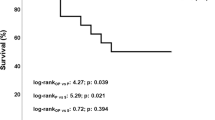Summary
Endotoxin induced necrosis of the Meth A mouse tumour has been investigated using macroscopic, histological and ultrastructural examination methods.
On the 8th day after tumour cell transplantation, the animals received a relatively non-toxic dose of the Salmonella abortus equi endotoxin intravenously. The natural history of the tumour necrosis took the following course:
-
1.
The earliest morphological changes could be seen with the electron microscope 90 min after administration of the endotoxin, and were seen as an interstitial oedema with separation of the tumour cells.
-
2.
Haemmorrhagic necrosis of the tumour was complete 4 hours after injection, and could be easily recognized with the naked eye.
-
3.
Rejection of the necrotic malignant tumour was complete two weeks after LPS administration. Only minor residual scarring of the belly-wall remained.
Haemorrhagic tumour necrosis due to endotoxin can be compared with the localized Shwartzman reaction and probably involves tumour necrotizing factor (TNF). For complete destruction of a tumour by haemorrhagic necrosis the size of the tumour is critical. Certain regression after endotoxin administration depends upon additional T-cell-mediated immunity (provided the tumour is immunogenic).
In contrast to the haemorrhagic necrosis, BCG-induced tumour regression is accompanied by granulomatous inflammation, which may be responsible for destruction of the tumour.
Similar content being viewed by others
References
Andervont HB (1936) The reaction of mice and of various mouse tumours to the injection of bacterial products. Am J Cancer 27:77–83
Apitz K (1933) Über Blutungsreaktionen am Impfcarcinom der Maus. Zeitschr Krebsforsch 40:50–70
Berendt MJ, Mezrow GF, Saluk PH (1978) Requirement of a radiosensitive lymphoid cell in the generation of lipopolysaccharide-induced rejection of a murine tumour allograft. Infect Immun 21:1033–1035
Bober LA, Kranepool MJ, Hollander VP (1976) Inhibitory effect of endotoxin on the growth of plasma cell tumour. Cancer Res 36:927–929
Busch (1866) Verhandlungen ärztlicher Gesellschaften. Berl Klin Wochenschr 3:245–247
Carswell EA, Old LJ, Kassel RL, Green S, Fiore N, Williamson B (1975) An endotoxin-induced serum factor that causes necrosis of tumours. Proc Nat Acad 5 Sci USA 72:3666–3670
Coley WB (1986) Further observations upon the treatment of malignant tumours with the toxin of erysipelas and bacillus prodogiosus, with a report of 160 cases. Bull Johns Hopkins Hosp 65:157–162
Diller IC (1947) Degenerative changes induced in tumour cells by Serratia marcescens polysaccharide. Cancer Res 7:605–626
Donnelly AJ, Havas HF, Groesbeck ME (1958) Mixed bacterial toxins in the treatment of tumours. II. Gross and microscopic changes produced in sarcoma 37 and in mouse tissues. Cancer Res 18:149–161
Galanos C, Lüderitz O, Westphal O (1969) A new method for the extraction of R lipopolysaccharides. Eur J Biochem 9:245–249
Galanos C, Lüderitz O, Westphal O (1979) Preparation and properties of a standardized lipopolysaccharide from Salmonella abortus equi (Novo Pyrexal): Zbl Bakt Hyg I. Abt Orig A 243:226–244
Green S, Dobrjansky A, Carswell EA, Kassel RL, Old LJ, Fiore N, Schwartz MK (1976) Partial purification of a serum factor that causes necrosis of tumours. Proc Natl Acad Sci USA 73:381–385
Grohsman J, Nowotny A (1972) The immune recognition of TA3 tumours, its facilitations by endotoxin, and abrogation by ascites fluid. J Immunol 109:1090–1095
Hanna MG, Zbar B, Rapp HJ (1972) Histopathologie of tumour regression after intralesional injection of mycobacterium bovis. I. Tumour growth and metastasis. J Nat Cancer Inst 48:1441–1455
Lemperle G (1966) Reticulo Endothelial System. J Reticul Soc 3:385
Mizuno D, Yoshioka O, Akamatu M, Kataoka T (1968) Antitumour effect of intracuteneous injection of bacterial lipopolysaccharide. Cancer Res 28:1531–1537
Old LJ, Clarke DA, Benacerraf B (1959) Effect of Bacillus Calmette-Guérin (BCG) infection on transplanted tumours in the mouse. Natur (London) 184:291–293
Old LJ, Benacerraf B, Clarke DA, Carswell A, Stockert E (1961) The role of the RES in the host reaction to neoplasia. Cancer Res 21:1281–1300
Parr I, Wheeler E, Alexander P (1973) Similarities of the antitumour actions of endotoxin, lipid A and double-stranded RNA. Br J Cancer 27:370
Ribi EE, Granger DL, Millner KC, Strain SM (1975) Brief communication: tumour regression caused by endotoxin and mycobacterial fractions. J Nat Cancer Inst 55:1253–1257
Ribi EE, Takayama K, Milner K, Gray GR, Green M, Parker R, Mc Laughlin C, Kelly M (1976) Regression of tumors by an endotoxin combined with trehalose mycolates of differing structure. Cancer Immunol Immunether 1:265
Shear MJ (1943) Chemical treatment of tumours. IX. Reactions of mice with primary subcutaneous tumours to injection of a hemorrhagic-producing bacterial polysaccharide. J Nat Cancer Inst 4:461
Shwartzman G, Michailowsky N (1932) Phenomenon of local skin reactivity to bacterial filtrates in the treatment of mouse sarcoma 180. Proc Soc Exper Biol Med 29:737–741
Stetson C (1961) Vascular effects of endotoxins. Bull NY Acad Sci 101:80
Tripoldi D, Hollenbeck L, Pollack W (1970) The effect of endotoxin on the implantation of a mouse sarcoma. Int Arch Allerby 37:575–585
Weiss DW, Bonhag RS, Leslie P (1966) Studies on the heterologous immunogenicity of a methanol-insoluble fraction of attenuated tubercle bacilli (BCG) II. Protection against tumour isografts. J Exp Med 124:1039–1065
Westphal O, Lüderitz O, Bister F (1952) Über die Extraktion von Bakterien mit Phenol/Wasser. Z Naturforsch 76:148–155
Yang C, Nowotny A (1974) Effect of endotoxin on tumour resistance in mice. Infect Immun 9:95–100
Author information
Authors and Affiliations
Rights and permissions
About this article
Cite this article
Freudenberg, N., Joh, K., Westphal, O. et al. Haemorrhagic tumour necrosis following endotoxin administration. Vichows Archiv A Pathol Anat 403, 377–389 (1984). https://doi.org/10.1007/BF00737287
Accepted:
Issue Date:
DOI: https://doi.org/10.1007/BF00737287




